Jenny Hasselqvist (1894-1978) was a Swedish ballet dancer and actress who starred in silent Swedish films by Mauritz Stiller and Victor Sjöström. She also worked in Germany with Ernst Lubitsch and became well-known all over Europe. With the rise of the sound film, she concluded her film career.
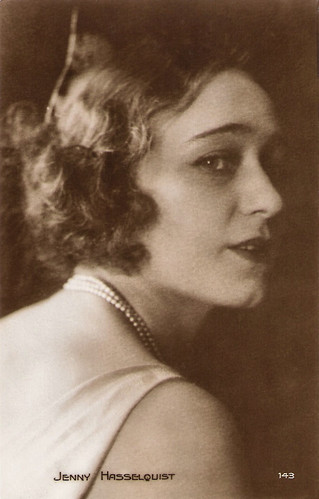
French postcard by Editions Cinémagazine, no. 143. Swedish actress Jenny Hasselqvist aka Jenny Hasselquist.
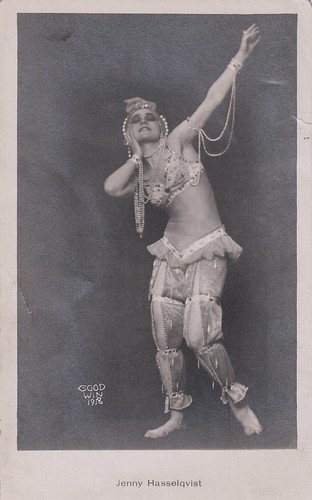
Vintage postcard. Photo: Henry B. Goodwin, 1918. Collection: Marlène Pilaete.

Swedish postcard by Axel Eliassons Konstförlag, Stockholm, no. 450. Photo: Ferd. Flodin. The crossed-out title seems to be 'En nate i Venedig' (A Night In Venice), which may refer to the ballet in 'Eine Nacht in Venedig' by Johan Strauss Jr.

Swedish postcard by Axel Eliassons Konstförlag, Stockholm, no. 451. Photo: Ferd. Flodin. The crossed-out title seems to be 'En nate i Venedig' (A Night In Venice), which may refer to the ballet in 'Eine Nacht in Venedig' by Johan Strauss Jr.

Swedish postcard by Förlag, Nordisk Konst, Stockholm, no. 1202. Photo: Ferd. Flodin, Stockholm.
Jenny Matilda Elisabet Hasselqvist (or Hasselquist) was born in 1894 in Stockholm, Sweden. Her father was a member of parliament. From 1906 on, Jenny attended the Swedish Opera's ballet school and from 1910, she performed with the Royal Ballet. In 1913, famous Russian choreographer Michel Fokine noticed her talents and ensured she obtained solo parts in La Sylphide and Cleopatra. She had a brilliant success and became a prima ballerina at the Royal Ballet in 1915.
In 1916, Hasselqvist made her film debut in Balettprimadonnan/Anjala the Dancer, directed by the legendary Mauritz Stiller. She got the title role because it required a professional dancer. At IMDb, ‘Herr Graf’ Ferdinand Von Galitzien highly recommends the film of which now only some fragments remain. ‘Genuine Stiller’, he calls the tale of a gypsy dancer (Hasselquist) who is discovered accidentally by a violin player (Lars Hanson). Von Galitzien about the film’s ending: "a thrilling sequence with our heroine running wild through a snowy landscape trying to avoid a calamity between the men that are fighting for her love (…), a lyrical and beautiful ending wherein Nature (Swedish style) is also an important dramatic character."
Hasselqvist continued to dance. In 1919, she retired from the Royal Ballet and became from 1919 till 1921 a star of Les ballets Anglais in Paris. Wikipedia: “A talented dancer, she had a flair for the modern idiom.” She also pursued a career in the silent cinema. With Mauritz Stiller, she made Johan/ Rapids of Life (Mauritz Stiller, 1921) with Mathias Taube and De landsflyktige/The Emigrants (Mauritz Stiller, 1921).
Then she worked with the other great director of the Swedish silent cinema, Victor Sjöström at Vem dömer/Love’s Crucible (Victor Sjöström, 1922) with Gösta Ekman, and Eld ombord/Fire on Board (Victor Sjöström, 1923) opposite British actor Matheson Lang and Victor Sjöström himself.
One of her best-known films is Gösta Berlings saga/The Atonement of Gosta Berling (Mauritz Stiller, 1924) starring Lars Hanson and the young Greta Garbo. Hal Erickson at AllMovie: "The Atonement of Gosta Berling is an excellent representation of the Swedish silent cinema. Long, complex, and elaborately produced, the film nonetheless never loses sight of the human elements which motivate the story." Hasselqvist also worked with Gustaf Molander at the Selma Lagerlöf adaptations Ingmarsarvet/The Ingmar Inheritance (Gustaf Molander, 1925) and Till österland/To the Orient (Gustaf Molander, 1926), with Lars Hanson and Ivan Hedqvist.

Swedish postcard by Ed. Almquist. Photo: Goodwin, 1918.The dancers Jenny Hasselqvist and Oscar Tropp.
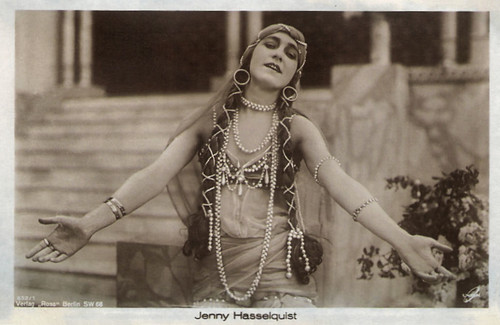
German postcard by Ross Verlag, Berlin, no. 832/1, 1919-1924. Union Film. Publicity still for Sumurun (Ernst Lubitsch, 1920).

German postcard by Ross Verlag, Berlin, no. 642/2,1919-1924. Union Film. Publicity still for Sumurun (Ernst Lubitsch, 1920) with Jenny Hasselqvist and Aud Egede Nissen. Collection: Didier Hanson.

Swedish postcard by Ed. Axel Eliassons Konstförlag, Stockholm, no. 294. Photo: Skandia Film, Stockholm. Jenny Hasselqvist in De landsflyktiga/The Emigrants/The Exiles (Mauritz Stiller, 1921).

Swedish postcard by Ed. Axel Eliassons Konstförlag, Stockholm, no. 298. Photo: Skandia Film, Stockholm. Jenny Hasselquist and Lars Hanson in De landsflyktiga/The Emigrants (Mauritz Stiller, 1921). This is a lost film, except for a few very short fragments.

Swedish postcard by Axel Eliassons Konstförlag, Stockholm, no. 301. Photo: Skandia Film, Stockholm. Jenny Hasselqvist in Vem dömer/Love's Crucible (Victor Sjöström, 1922).
Jenny Hasselqvist also worked in Germany. In 1920, Ernst Lubitsch offered her the title role in his film version of Max Reinhardt's stage pantomime Sumurun/One Arabian Night (Ernst Lubitsch, 1920), opposite Ernst Lubitsch himself and Pola Negri. Hasselqvist played the favourite slave girl of a tyrannical sheikh (Paul Wegener), who fell in love with a cloth merchant (Harry Liedtke). The film was a huge international success and she became well-known in Europe.
In Germany she also played in Das brennende Geheimnis/The Burning Secret (Rochus Gliese, 1923) and Die Perücke/The Wig (Berthold Viertel, 1925) as the wife of Otto Gebühr. About the latter Gwynplaine writes on IMDb: “It's been ten years since I saw Berthold Viertel's compelling film Die Perucke (or the Wig) at the Pordenone Silent Film Festival back in 1997. But of all the films I have seen throughout that eventful week (including some impressive silents from China...) I would have to say that Die Perucke was the most impressive. The story concerns a man in the 1920s who, while visiting an antique shop, discovers an old powdered wig. While trying the wig on he is instantly whisked back to the 1700's & becomes the nobleman who originally wore the wig.”
Hasselqvist’s later German films include Brennende Grenze/Aftermath (Erich Waschneck, 1927) and Schuldig/Guilty (Johannes Meyer, 1928) with Suzy Vernon. With the rise of the sound film, she concluded her film career. Her final film was the Paramount production Den farliga leken (Gustaf Bergman, 1931), an alternative language version of The Laughing Lady (Victor Schertzinger, 1929) with Ruth Chatterton.
Hasselqvist had starred in 20 films, but the voice was not her medium. During her film career, she appeared as a guest dancer in many of Europe's leading theatres including the Coliseum in London, the Théâtre des Champs-Élysées in Paris and the Deutsches Theater in Berlin. From the mid-1930s on, she had her own ballet school in Stockholm, and in the early 1950s, she also taught at the Stockholm Opera's ballet school. In between she incidentally returned to act on stage.
At the age of 83, Jenny Hasselqvist died in 1978 in Täby, near Stockholm. She was married to artist, painter and ceramist Wilhelm Kage (1918-1922) and to garden architect Gösta Reuterswärd (1923-1927).
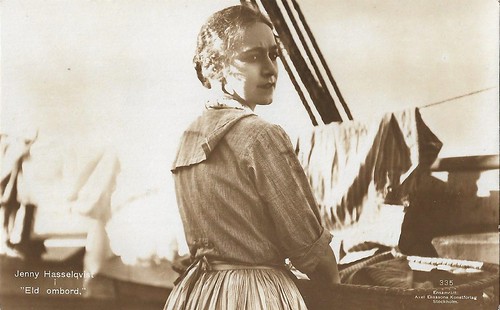
Swedish postcard by Axel Eliassons Konstförlag, Stockholm, no. 335. Photo: Svensk Filminspelning. Jenny Hasselqvist in Eld ombord/Fire on board/The Hell Ship (Victor Sjöström, 1923).

German postcard by Trianon-Film, 1924. Photo: Svenska-Film. Karin Swanström, Sixten Malmerfelt and Jenny Hasselqvist in Gösta Berlings saga/The Atonement of Gosta Berling (Mauritz Stiller, 1924).
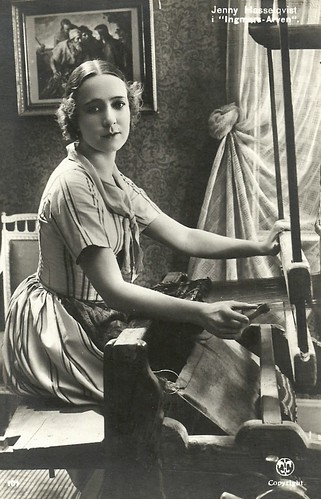
Danish postcard by Alex. Vincent's Kunstforlag, Copenhagen, no. 101. Jenny Hasselqvist in Ingmarsarvet/The Ingmar Inheritance (Gustav Molander, 1925), based on Selma Lagerlöf's book 'Jerusalem'.

German postcard by Ross Verlag, no. 1260/1, 1927-1928. Photo: Deulig (Deutsche Lichtbild-Gesellschaft).
Short dance fragment of Jenny Hasselvuist performing 'Die weiße Rose' (The White Rose), from the German 'health and efficiency' film Wege Zu Kraft und Schonheit/Paths to the Power & Beauty (1925). Source: John Hall (YouTube).
Homage to Lars Hanson and Jenny Hasselqvist in 1924, with Cristal um tango sung by Francisco Alves. Source: Radio Santos (YouTube).
Sources: Ferdinand Von Galitzien (IMDb), Gwynplaine (IMDb), Bengt Forslund (The Swedish Film Database - Swedish), Wikipedia (English and Swedish) and IMDb.
This post was last updated on 25 August 2024.

French postcard by Editions Cinémagazine, no. 143. Swedish actress Jenny Hasselqvist aka Jenny Hasselquist.

Vintage postcard. Photo: Henry B. Goodwin, 1918. Collection: Marlène Pilaete.

Swedish postcard by Axel Eliassons Konstförlag, Stockholm, no. 450. Photo: Ferd. Flodin. The crossed-out title seems to be 'En nate i Venedig' (A Night In Venice), which may refer to the ballet in 'Eine Nacht in Venedig' by Johan Strauss Jr.

Swedish postcard by Axel Eliassons Konstförlag, Stockholm, no. 451. Photo: Ferd. Flodin. The crossed-out title seems to be 'En nate i Venedig' (A Night In Venice), which may refer to the ballet in 'Eine Nacht in Venedig' by Johan Strauss Jr.

Swedish postcard by Förlag, Nordisk Konst, Stockholm, no. 1202. Photo: Ferd. Flodin, Stockholm.
Prima donna
Jenny Matilda Elisabet Hasselqvist (or Hasselquist) was born in 1894 in Stockholm, Sweden. Her father was a member of parliament. From 1906 on, Jenny attended the Swedish Opera's ballet school and from 1910, she performed with the Royal Ballet. In 1913, famous Russian choreographer Michel Fokine noticed her talents and ensured she obtained solo parts in La Sylphide and Cleopatra. She had a brilliant success and became a prima ballerina at the Royal Ballet in 1915.
In 1916, Hasselqvist made her film debut in Balettprimadonnan/Anjala the Dancer, directed by the legendary Mauritz Stiller. She got the title role because it required a professional dancer. At IMDb, ‘Herr Graf’ Ferdinand Von Galitzien highly recommends the film of which now only some fragments remain. ‘Genuine Stiller’, he calls the tale of a gypsy dancer (Hasselquist) who is discovered accidentally by a violin player (Lars Hanson). Von Galitzien about the film’s ending: "a thrilling sequence with our heroine running wild through a snowy landscape trying to avoid a calamity between the men that are fighting for her love (…), a lyrical and beautiful ending wherein Nature (Swedish style) is also an important dramatic character."
Hasselqvist continued to dance. In 1919, she retired from the Royal Ballet and became from 1919 till 1921 a star of Les ballets Anglais in Paris. Wikipedia: “A talented dancer, she had a flair for the modern idiom.” She also pursued a career in the silent cinema. With Mauritz Stiller, she made Johan/ Rapids of Life (Mauritz Stiller, 1921) with Mathias Taube and De landsflyktige/The Emigrants (Mauritz Stiller, 1921).
Then she worked with the other great director of the Swedish silent cinema, Victor Sjöström at Vem dömer/Love’s Crucible (Victor Sjöström, 1922) with Gösta Ekman, and Eld ombord/Fire on Board (Victor Sjöström, 1923) opposite British actor Matheson Lang and Victor Sjöström himself.
One of her best-known films is Gösta Berlings saga/The Atonement of Gosta Berling (Mauritz Stiller, 1924) starring Lars Hanson and the young Greta Garbo. Hal Erickson at AllMovie: "The Atonement of Gosta Berling is an excellent representation of the Swedish silent cinema. Long, complex, and elaborately produced, the film nonetheless never loses sight of the human elements which motivate the story." Hasselqvist also worked with Gustaf Molander at the Selma Lagerlöf adaptations Ingmarsarvet/The Ingmar Inheritance (Gustaf Molander, 1925) and Till österland/To the Orient (Gustaf Molander, 1926), with Lars Hanson and Ivan Hedqvist.

Swedish postcard by Ed. Almquist. Photo: Goodwin, 1918.The dancers Jenny Hasselqvist and Oscar Tropp.

German postcard by Ross Verlag, Berlin, no. 832/1, 1919-1924. Union Film. Publicity still for Sumurun (Ernst Lubitsch, 1920).

German postcard by Ross Verlag, Berlin, no. 642/2,1919-1924. Union Film. Publicity still for Sumurun (Ernst Lubitsch, 1920) with Jenny Hasselqvist and Aud Egede Nissen. Collection: Didier Hanson.

Swedish postcard by Ed. Axel Eliassons Konstförlag, Stockholm, no. 294. Photo: Skandia Film, Stockholm. Jenny Hasselqvist in De landsflyktiga/The Emigrants/The Exiles (Mauritz Stiller, 1921).

Swedish postcard by Ed. Axel Eliassons Konstförlag, Stockholm, no. 298. Photo: Skandia Film, Stockholm. Jenny Hasselquist and Lars Hanson in De landsflyktiga/The Emigrants (Mauritz Stiller, 1921). This is a lost film, except for a few very short fragments.

Swedish postcard by Axel Eliassons Konstförlag, Stockholm, no. 301. Photo: Skandia Film, Stockholm. Jenny Hasselqvist in Vem dömer/Love's Crucible (Victor Sjöström, 1922).
Sumurun
Jenny Hasselqvist also worked in Germany. In 1920, Ernst Lubitsch offered her the title role in his film version of Max Reinhardt's stage pantomime Sumurun/One Arabian Night (Ernst Lubitsch, 1920), opposite Ernst Lubitsch himself and Pola Negri. Hasselqvist played the favourite slave girl of a tyrannical sheikh (Paul Wegener), who fell in love with a cloth merchant (Harry Liedtke). The film was a huge international success and she became well-known in Europe.
In Germany she also played in Das brennende Geheimnis/The Burning Secret (Rochus Gliese, 1923) and Die Perücke/The Wig (Berthold Viertel, 1925) as the wife of Otto Gebühr. About the latter Gwynplaine writes on IMDb: “It's been ten years since I saw Berthold Viertel's compelling film Die Perucke (or the Wig) at the Pordenone Silent Film Festival back in 1997. But of all the films I have seen throughout that eventful week (including some impressive silents from China...) I would have to say that Die Perucke was the most impressive. The story concerns a man in the 1920s who, while visiting an antique shop, discovers an old powdered wig. While trying the wig on he is instantly whisked back to the 1700's & becomes the nobleman who originally wore the wig.”
Hasselqvist’s later German films include Brennende Grenze/Aftermath (Erich Waschneck, 1927) and Schuldig/Guilty (Johannes Meyer, 1928) with Suzy Vernon. With the rise of the sound film, she concluded her film career. Her final film was the Paramount production Den farliga leken (Gustaf Bergman, 1931), an alternative language version of The Laughing Lady (Victor Schertzinger, 1929) with Ruth Chatterton.
Hasselqvist had starred in 20 films, but the voice was not her medium. During her film career, she appeared as a guest dancer in many of Europe's leading theatres including the Coliseum in London, the Théâtre des Champs-Élysées in Paris and the Deutsches Theater in Berlin. From the mid-1930s on, she had her own ballet school in Stockholm, and in the early 1950s, she also taught at the Stockholm Opera's ballet school. In between she incidentally returned to act on stage.
At the age of 83, Jenny Hasselqvist died in 1978 in Täby, near Stockholm. She was married to artist, painter and ceramist Wilhelm Kage (1918-1922) and to garden architect Gösta Reuterswärd (1923-1927).

Swedish postcard by Axel Eliassons Konstförlag, Stockholm, no. 335. Photo: Svensk Filminspelning. Jenny Hasselqvist in Eld ombord/Fire on board/The Hell Ship (Victor Sjöström, 1923).

German postcard by Trianon-Film, 1924. Photo: Svenska-Film. Karin Swanström, Sixten Malmerfelt and Jenny Hasselqvist in Gösta Berlings saga/The Atonement of Gosta Berling (Mauritz Stiller, 1924).

Danish postcard by Alex. Vincent's Kunstforlag, Copenhagen, no. 101. Jenny Hasselqvist in Ingmarsarvet/The Ingmar Inheritance (Gustav Molander, 1925), based on Selma Lagerlöf's book 'Jerusalem'.

German postcard by Ross Verlag, no. 1260/1, 1927-1928. Photo: Deulig (Deutsche Lichtbild-Gesellschaft).
Short dance fragment of Jenny Hasselvuist performing 'Die weiße Rose' (The White Rose), from the German 'health and efficiency' film Wege Zu Kraft und Schonheit/Paths to the Power & Beauty (1925). Source: John Hall (YouTube).
Homage to Lars Hanson and Jenny Hasselqvist in 1924, with Cristal um tango sung by Francisco Alves. Source: Radio Santos (YouTube).
Sources: Ferdinand Von Galitzien (IMDb), Gwynplaine (IMDb), Bengt Forslund (The Swedish Film Database - Swedish), Wikipedia (English and Swedish) and IMDb.
This post was last updated on 25 August 2024.
No comments:
Post a Comment